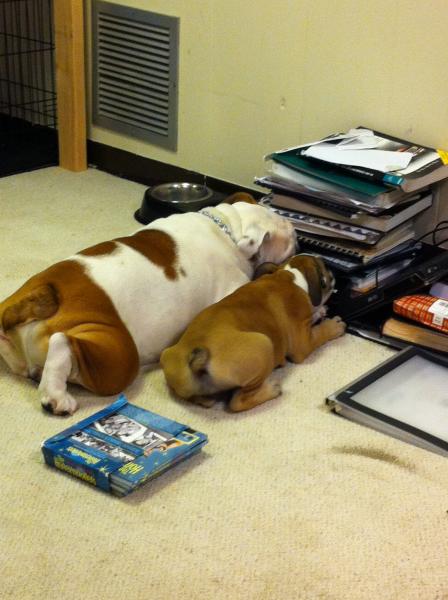
Dozer over heated HELP!
Submitted by Nickieanddozie on July 9, 2011 - 4:11pmi thought he was away someone let him out..
hes laying on my cold floor now, wont really drink!/ how so i cool him down!?!?!?!?
HELPP
__________________
Nicole, Dozer and baby harley <3



READ THIS NOW!
Take the pet's temperature rectally if possible. A normal temperature is between 101-102 degree. A body temperature of about 104 degrees or higher is probable evidence for heat stroke. Place your pet in a tub of cool running water or spray with a hose being sure the cool water contacts the skin and doesn't simply run off the coat. Thoroughly wet the belly and inside the legs. In extreme cases use a ice pack under the neck and front leg pits. Take a rectal temperature if possible to know when to stop cooling. A safe temperature is below 103 degrees to stop the cooling process.
The first signs of heat exhaustion: a) Excessive panting b) The skin on the inside of the ears becomes flushed and red. Heat Exhaustion can progress in to Heat Stroke, as indicated by: a) Weakness b) Staggering c) Fainting - loss of consciousness Heat stroke is an emergency situation. If your dog shows signs of heat stroke, you must cool him down as rapidly as possible. Don't wait for veterinary treatment. Heat Stroke is an Emergency - Treat the dog NOW! DO NOT try to force your dog to drink. His swelling airways can cause any liquid he takes in to be regurgitated and possibly aspirated into his lungs. However if a dogs temperature is 105 or higher rub a piece of ice on his tongue, 10 seconds on, 10 seconds off. Hose the dog down with cool water - not cold. Apply an ice pack to the dog, and soaked towels or any other form of fabric to their body.
If at all possible, get him into a tub of cool water -- again, cool - not cold! However, in an extreme emergency if cold is all there is, use it. If none of this is working, a cool water enema can help to cool the dog internally. Be careful not to induce to rapidly, or with water cooler than a few degrees below body temp, or you can put your dog into serious shock. As your dog is panting, his airways are swelling, causing him to pant harder yet again. You need to break this cycle. Children's allergy treatment Benadryl can be administered by mouth from dropper. Consult your vet in advance, or by phone is necessary, for exact dosage. Better still is to obtain a supply of injectible Benadryl to keep on hand. Do not stop treatment until your dog's body temperature is below 103. As soon as the dog's internal temperature has stabilized at a near normal level transport the dog to your vet. Heat stroke can leave permanent damage.
Amy and Sophia